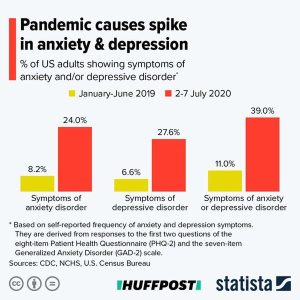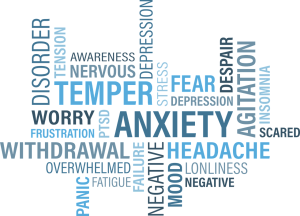13
Morgan Friday
Introduction
Keywords
Pandemic
Mental Heath
COVID-19
Learning Objectives
- Understand the types of people COVID-19 has affected mentally
- Learn how quarantining and social distancing affect mental health
- Understand how medical care professionals are impacting using a case study
- Learn about some solutions to dealing with mental health during the pandemic
COVID-19 has affected the mental health of a wide range of people including patients, medical professionals, and many other types of people. It is no shock that the recent pandemic has impacted people in so many different ways. One of the biggest factors that has been affected is mental health. Social distancing and isolation are very hard things for humans to experience, especially for a span of months. Overall mental health has declined over the span of this pandemic (Pfefferbaum, North, 2020). While this situation has no end in sight, there are many actions that are being taken to improve the mental health of those affected.
There has been an overall decrease in mental health due to COVID-19. There is a group of disadvantaged people that experience even more hardships mentally. The year of 2020 has been a year of surprises. COVID-19 is nothing short of a surprise. Most people did not expect the virus to impact our daily lives as much as it has. Social isolation, quarantine, and social distancing were things that were unheard of prior to COVID-19. Now, these things have impacted us, especially regarding mental health. There has been an increase in mental illness diagnoses during COVID-19. The most common illnesses include depression, insomnia, and anxiety (Pfefferbaum, North, 2020). Young adults, women, people that are unemployed, and people with low income are at a disadvantage in dealing with COVID-19 and have struggled more with mental health during these times. It has been found that women have been experiencing more depressive symptoms and a lower quality of life compared to men. Those who are under the age of 35 have scored a lot lower on mental health assessments. 30% of people under the age of 35 have experienced depressive symptoms vs only 5% of those older than 65 (Pfefferbaum, North, 2020). People that have mild to moderate mental illnesses are twice as likely to be unemployed. A reduction in household income is also affiliated with mental illnesses. While it is alarming to hear of the increase of mental illnesses during the pandemic, it is even scarier to think of the long term effects these mental illnesses will cause. There is no way to know or understand how anyone will be permanently impacted by COVID-19.

“Covid-19 Mental Health Impact in the United States “ by Huffington Post is licensed under CC BY 4.0
Mental Health of Patients
Patients are extremely vulnerable to the psychological effects of the pandemic. There are many factors that patients have to experience exclusively when recovering from the virus that affect mental health. Those who have contracted COVID-19 are one of the most vulnerable subsets of the population to developing mental disorders (Usher, Bhullar, & Jackson, 2020). Patients at higher risk (elderly and compromised immunity) are even more vulnerable to be affected mentally. Those in hospitals have not been able to have visitors come which only increases the effects of isolation. This can be a very lonely experience and those that already suffer from anxiety and depression usually experience even worse side effects. There is also a stress of which loved ones have been exposed to the virus. For example, potentially exposing a grandparent with health conditions is very stressful.

“Mental Health Birds” by NeedPix is licensed under CC
Mental Health of Medical Professionals
Medical professionals who have been caring with those diagnosed with COVID-19 have also experienced a decline in their mental health. These people have had to work long, stressful hours during the pandemic. In 2019, COVID-19 was first reported in Wuhan, China (Kang, Lijun, 2020). This immediately impacted the medical staff in this area as they were one of the first to have to treat this illness. Towards the beginning of the pandemic, there was an increase of fear and anxiety which quickly decreased and developed into depression, psychophysiological symptoms. This was due to being isolated, working in stressful high-risk positions, and having contact with infected people (Kang, Lijun, 2020). Other factors that have affected medical staff include inadequate testing, limited treatment options, and insufficient PPE and medical supplies.
Mental Health of family members, pregnant women, and college students
Family members, pregnant women, and college students have also been heavily impacted with mental health effects during the pandemic.
Family Members
Isolation from loved ones is known to cause psychosocial problems for family members. The most vulnerable in isolating situations are children, older adults, minority groups, lower socio-economic groups, females, and people with mental health conditions. Those who are responsible for caring for family members have also been impacted. This is a high-stress situation that many people have had to face. In many cases, visitors have not been allowed in hospitals and doctors offices which makes it even more stressful for those who are caring for children or older adults.
Pregnant Women
It is also known that women who are pregnant that catch COVID-19 can potentially experience implications. There is also a limited amount of drugs that can be used to treat the illness (Haruna, Megumi, & Daisuke Nishi, 2020). This pandemic has also impacted the normal events of childbirth such as visitors in the hospital and waiting for a period of time before loved ones can meet the baby.
College Students
71% of college students indicated increased stress, anxiety, and depressive thoughts. This included fear of their own health and the health of loved ones, troubles concentrating, insomnia, limited social interactions, and a decrease in academic performances (Son, Hedge, Smith, Wang, & Sasangohar, 2020).
Mental Health of family members, pregnant women, and college students
Family members, pregnant women, and college students have also been heavily impacted with mental health effects during the pandemic.
Family Members
Isolation from loved ones is known to cause psychosocial problems for family members. The most vulnerable in isolating situations are children, older adults, minority groups, lower socio-economic groups, females, and people with mental health conditions. Those who are responsible for caring for family members have also been impacted. This is a high-stress situation that many people have had to face. In many cases, visitors have not been allowed in hospitals and doctors offices which makes it even more stressful for those who are caring for children or older adults.
Pregnant Women
It is also known that women who are pregnant that catch COVID-19 can potentially experience implications. There is also a limited amount of drugs that can be used to treat the illness (Haruna, Megumi, & Daisuke Nishi, 2020). This pandemic has also impacted the normal events of childbirth such as visitors in the hospital and waiting for a period of time before loved ones can meet the baby.
College Students
71% of college students indicated increased stress, anxiety, and depressive thoughts. This included fear of their own health and the health of loved ones, troubles concentrating, insomnia, limited social interactions, and a decrease in academic performances (Son, Hedge, Smith, Wang, & Sasangohar, 2020).
Solutions
Some solutions for combating mental health during the pandemic includes telemedicine, guidance from healthcare providers, and mental healthcare for medical professionals. Telemedicine has been introduced and offers psychosocial services at home. This includes queries of COVID-19 related stressors (Pfefferbaum, North, 2020). Exposures, infected family members, loss of loved ones, and isolation. Previously telemedicine was not used frequently enough to be seen as a “normal” appointment because it was not accepted by health professionals. Learning curves have been forced to occur during periods of shut down. Many healthcare providers are able to offer patients and family members suggestions to manage the stress of the pandemic (Kang, Lijun, 2020). This can include structured activities and maintaining a routine. This also includes referrals to mental health services. To combat the amount of medical professionals experiencing mental illnesses, a greater availability of personalized mental health care would benefit them.

Mental Health Word Cloud by NeedPix is licensed under CC
Chapter Summary
- COVID-19 has had a huge impact on so many different people all over the world. One of the major things that has been affected is mental health.
- Patients have shown to have a decline in their mental health due to many reasons including strict isolation and stress due to fighting the virus.
- Medical professionals are forced to work long hours in very stressful conditions. Many have had a decline in their mental health.
- Other subsets of society that have been affected include family members of those infected, pregnant women, and college students.
- There have been some solutions that have been introduced to those suffering from a decline in their mental health due to the virus.
Review Questions
- List some groups of people that have experienced a decline in mental health due to COVID-19:
- Explain how isolation and social distancing affects mental health:
- Telehealth has been introduced to provide mental health visits online. (T/F)
- COVID-19 was first reported in Los Angeles, CA. (T/F)
- Young women and people who are unemployed are at a disadvantage in dealing with COVID-19. (T/F)
Answers: 3 – T, 4 – F, 5 – T
References:
Haruna, Megumi, and Daisuke Nishi. “Perinatal Mental Health and COVID‐19 in Japan.” Psychiatry and clinical neurosciences 74.9 (2020): 502–503. Web.
Kang, Lijun, et al. “Impact on Mental Health and Perceptions of Psychological Care among Medical and Nursing Staff in Wuhan during the 2019 Novel Coronavirus Disease Outbreak: A Cross-Sectional Study.” Brain, Behavior, and Immunity, Elsevier Inc., July 2020, www.ncbi.nlm.nih.gov/pmc/articles/PMC7118532/.
Pfefferbaum, B., North, C. S., J. H. Beigel and Others, L. A. Jackson and Others, & A. G. Letizia and Others. (2020, November 05). Mental Health and the Covid-19 Pandemic: NEJM. Retrieved November 17, 2020, from https://www.nejm.org/doi/full/10.1056/NEJMp2008017
Son C, Hegde S, Smith A, Wang X, Sasangohar F. (2020, September 09). Effects of COVID-19 on College Students’ Mental Health in the United States: Interview Survey Study.
Usher, K., Bhullar, N., & Jackson, D. (2020, May 06). Life in the pandemic: Social isolation and mental health. Retrieved November 17, 2020, from https://onlinelibrary.wiley.com/doi/full/10.1111/jocn.15290
